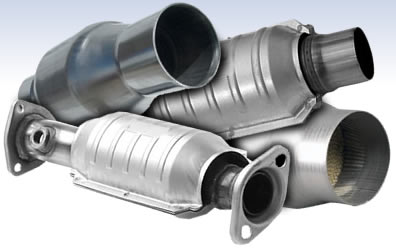 There are a handful of telltale signs your catalytic converter is on the fritz.
There are a handful of telltale signs your catalytic converter is on the fritz.
- Poor acceleration when stepping on the gas pedal
- Noticeably less fuel efficiency
- Dark, sooty smoke exiting your muffler
- Engine starting trouble
- Failing an emissions test
- A pungent sulfuric or rotten smell
- A Check Engine light in conjunction with any of these other symptoms
Faulty catalytic converters will often give you acceleration troubles. You step on the gas and all you feel is a jerky, inconsistent response. This is caused by a buildup of backpressure because of blockage in your exhaust. When air can’t escape, fresh air can’t come in.
An effective way to test for a blocked or plugged catalytic converter is with a vacuum gauge. By connecting the gauge to an intake vacuum on your intake manifold, throttle body, or carburetor, and recording your reading at idle, you can watch the needle as you rev the engine to increased rpm.
If all is well, you’ll see the vacuum reading stabilize.
If the vacuum reading drops, there’s a good chance backpressure is building in your exhaust system.
Overheating is another common problem with catalytic converters. Often, a failed oxygen sensor is the culprit. Oxygen sensors regulate your air-fuel mixture. When they go bad, they send incorrect information to your vehicle’s computer which can make it interpret your vehicle data as your exhaust running lean.
To compensate, your vehicle responds with a rich fuel mixture. Over time, this will clog your cat and lead to overheating, and most likely, an expensive replacement job.
If the time has come to replace your catalytic, you’ll want to check out our earlier post on choosing the right catalytic converter.

[…] to sulfur dioxide properly. This smell can also be attributed to a poor running engine, causing the catalytic converter to become overloaded and fail due to […]
This is the worst Cat post ever. Im a proffesional auto emmision inspector and repair technician for the state of Ca. None of the suggested methods are viable test. Placing a pressure gauge in place of an O2 sensor and having 2.75 lbs or more of back pressure is a clear indicator, a P0420 is another. Testing emissions with a 5 gas analyzer befor and after the cat is another. Ir heat gun tester before and affter is yet another proper way of cat testing. Looking for 100-200 degree increase in temp after the cat. 02 sensor data upstream and compare to down stream. If they mimic one another is procedure to codemn a cat. Do not replace a cat using the information this post describes. Cats can cost $65-$3000 dollars due to the precioys metals inside. Platinum, paltium, cerium and rodium. Plus the cost of labor. Very bad instructions.
My truck was running fine then I noticed a rich smell coming and going for a few days now my truck will run fine for a mile or two then starts acting like it’s running off 4 cylinders my friend was driving behind me and said there was a flame coming out of the tips when I was trying to get it up the hill dose this sound like a clogged cat?
I recently had all three cats replaced on my 2001 Ford Escape. Twice I have gotten out of my car after a many mile drive and put the car in park. The engine roared like I was going 100ph and the rpm meter went crazy. What’s up? Does it have to do with replacing the cats? Thanks
As you said replacing a catalytic converter can be really expensive! That’s why an environmentally, economically solution to cover a part of those costs can be to sell and recycle your used catalytic converter. Given precious metals contained in them, they are valuable. We do buy catalytic converters and give accurate quotations, you can have a look on our website if you’re interested!
This post is spot on!
The easiest way to test a bad catalytic converter is by using a vacuum pressure gauge. Temperature fluctuations are tell tale sign as well from before and after the cat if you have the equipment to measure the heat and I’m pretty sure not everyone possesses a 5 gas analyzer in which is pretty much unheard of in Michigan lol
Before scan tools vacuum gauges and compression testing units were common to diagnose vast mechanical problems.
After you submit within the number the service can give
you the essential information who the quantity
belongs to. I collect modern ones also and sandwich these to my existing collection. You’ll want to examine many reviews of the movie when searching for good
Netflix movies to watch with the service.
Thanks for sharing such an informative blog…
Everyone should be aware of the basic aspects of car care.
The catalytic converter is an important part of the vehicle and malfunctions in such an important component might jeopardize the performance of the vehicle.
So, the condition of different components of the vehicle should be subjected to inspection on a daily basis and malfunctions need to be repaired.
Its an older toyota lrxas
Has a v8 motor,, is it the catalytic converter. Is it worth fixing. It’s a 60.00 dollar car. Not sure I can fix it. What do,you suggest